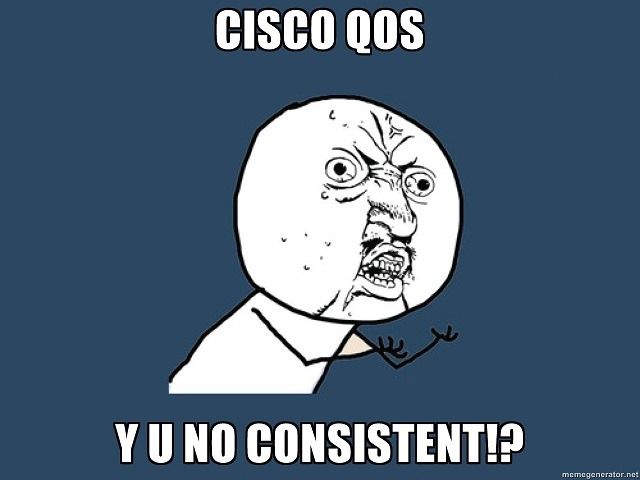QoS fields

The QoS fields used by the network device depend on the capabilities of the device and the QoS deployments of the network. Below is a little info about a few of these fields. This post will be edited over time with more info added.
A table showing some of the QoS fields available:
| Field | Location | Length | Description |
| Discard Eligible (DE) | Frame relay header | 1bit | Frames marked with DE will be discarded to avoid having to drop non DE marked frames. Can be used when policing. |
| Cell Loss Priority (CLP) | ATM cell header | 1bit | The ATM equivalent of the frame realy DE bit |
| Class of Service (CoS) | ISL and 802.1Q/P headers | 3bits | Provides up to seven different classes for frames crossing layer 2 trunk links. |
| MPLS Experimental | MPLS headers | 3bits | Map IP precedence etc onto the MPLS label to allow for QoS without looking past the label. |
| QoS Group | Internal to a Cisco router | N/A | A value between 1 and 99 is used to mark traffic internally to the router i.e. doe not modify the IP packet in any way. Only specific Cisco routers support this. |
| IP Precedence | IP Packet header | 3bits | First three (most significant) bits of the ToS byte in an IP packet header. Offers eight different classes. |
| DSCP | IP Packet header | 6bits | First six (most significant) bits of the DS byte in an IP packet header. |
| ToS byte | IP Packet header | 1byte (8bits) | A one byte field in an IP Packet header. (replaced by the DS byte) |
| DS byte | IP Packet header | 1byte (8bits) | A one byte field in an IP Packet header when Diffserv is in use this replaces the ToS byte. Defined under RFC 2475 |
Layer 2
CoS:
Table showing various CoS info:| CoS | Decimal Value | Binary Value |
| Routine | 0 | 000 |
| Priority | 1 | 001 |
| Immediate | 2 | 010 |
| Flash | 3 | 011 |
| Flash override | 4 | 100 |
| Critical | 5 | 101 |
| Internetwork control | 6 | 110 |
| Network control | 7 | 111 |
Layer 3
At Layer 3 there is the DSCP and IP Precedence fields that can be used.DSCP:
A table showing the various DSCPs, PHBs and a short description of the QoS each class should expect:| DSCPs | QoS to expect | PHB |
| BE (default) | No specific treatment. Default when traffic is not marked. | Best Effort (BE) |
| CS1,CS2,CS3,CS4, CS5,CS6,CS7 | The general rule for CS is bigger is better. High the DSCP the better the QoS allowance. | Class Selector (CS) |
| AF11,AF12,AF13,AF21,AF22,AF23,AF31,AF32,AF33,AF41,AF42,AF43 | Provides A minimum amount of "guaranteed" bandwidth to each of the four queues and within each of the queues three different drop thresholds. Does NOT always follow bigger is better rule. | Assured Forwarding (AF) |
| EF | Provides a low jitter ,delay and loss queue. Also provides a guaranteed amount of bandwidth but this should be policed to avoid other queues being starved | Expedited Forwarding (EF) |
Each of the four Assured Forwarding PHBs has three levels of drop threshold meaning that even within an AF PHB traffic can be differentiated.
EF offers the very best QoS can offer, usually reserved for voice traffic (not including voice signalling). Should always be policed to ensure other queues are not starved!
IP Precedence:
A table showing various IP Precedence info:| IP Precedence | Decimal Value | Binary Value |
| Routine | 0 | 000 |
| Priority | 1 | 001 |
| Immediate | 2 | 010 |
| Flash | 3 | 011 |
| Flash override | 4 | 100 |
| Critical | 5 | 101 |
| Internetwork control | 6 | 110 |
| Network control | 7 | 111 |
More info about mapping and relationships can be seen here
m00nie :)
